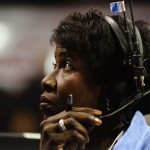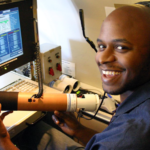By FELICIA FONSECA
Associated Press
FLAGSTAFF, Ariz. (AP) _ Navajo President Ben Shelly’s hopes for a second term were dashed Tuesday when he failed to make it through the tribe’s primary election.
Navajo voters chose to send former President Joe Shirley Jr. and one-time Arizona Rep. Chris Deschene to the November general election. They were among 17 candidates vying for the top elected post on the country’s largest American Indian reservation.
Rounding out the top five were Navajo lawmaker Russell Begaye; Donald Benally, the third-place finisher in the 2010 primary; and Navajo lawmaker Kenneth Maryboy. Shelly placed seventh. The results are unofficial until certified by the tribe’s elections office.
Shirley, of Chinle, sought a third consecutive term in 2010 but was barred by tribal law that states Navajo presidents are limited to two back-to-back terms. He entered this year’s race intent on getting another chance to overhaul the tribal government. Shirley spearheaded the tribe’s first successful ballot initiative to reduce the Navajo Nation Council from 88 to 24 members and secure a presidential line-item veto.
“One of the things we’ve said is we’re looking for honest leadership, leadership with integrity and people who can get things done,” Shirley said. “I think that had a big bearing on our win.”
The latter part of his tenure was marked by a tumultuous relationship with the Tribal Council over the ballot initiative, a set of traditional Navajo laws and the tribe’s business dealings with two companies that operated on the reservation.
Deschene, of LeChee, is a graduate of the U.S. Naval Academy who served in the U.S. Marine Corps. He has worked as an engineer and lawyer, and served one term in the Arizona House. In 2010, he won the Democratic nomination for Arizona secretary of state but lost to Republican Ken Bennett.
Deschene has said he would work to defend the Navajo way of life, and protect the environment and the tribe’s natural resources. But he said it’s a shared responsibility.
“Tonight is a representation of our nation wanting to go another direction,” he told Navajo radio station KTNN.
Shelly had said a vote for him would ensure continuity in the tribal government. During his tenure, the tribe fully passed federal reviews for its Head Start program for the first time in two decades, received a roughly $1 billion settlement to clean up uranium contaminated sites and began producing tribal identification cards.
But Shelly’s staff was plagued by turnover and his speaking gaffes. The same things he counted as successes, including the purchase of a coal mine and a water rights agreement that failed to pass the Tribal Council, were highly criticized.
“It’s disappointing to see that the accomplishments were not the overriding reason that people voted,” said Shelly’s campaign manager, Deswood Tome.
Whoever becomes the next president will oversee 12 executive branch directors, about two dozen staff members, and the majority of the tribal budget. The president earns $55,000 a year, and wields important influence in Indian Country.
Other tribes have looked at the Navajo Nation as a model for incorporating traditional laws into the court system and for securing regulatory authority over air and water from the U.S. Environmental Protection Agency.
The president represents the tribe to state, county and federal agencies. However, the post generally is seen as less powerful than the Tribal Council.
Candidates do not run on party lines and can receive campaign contributions from Navajos only once they file for the office. Candidates spent long hours campaigning on the 27,000 square-mile reservation that extends into Arizona, New Mexico and Utah, and ran political advertisements mostly on the radio.
Some of the presidential debates were conducted in Navajo, making it important for candidates to be fluent in the language to capture voters.










